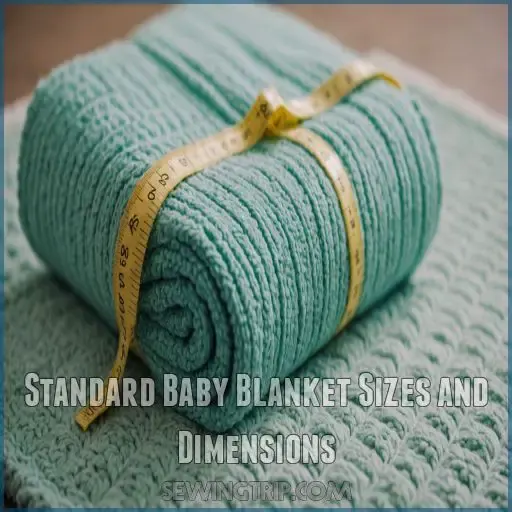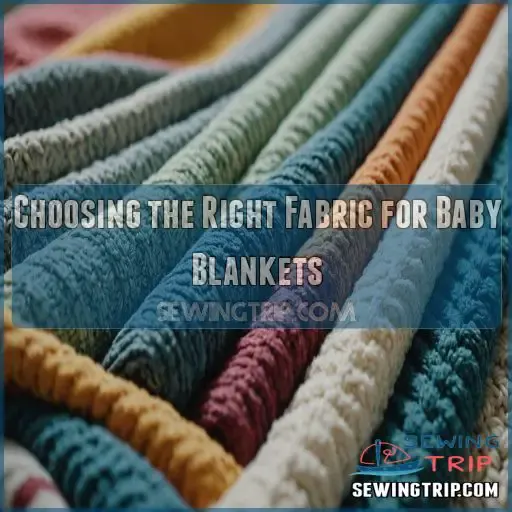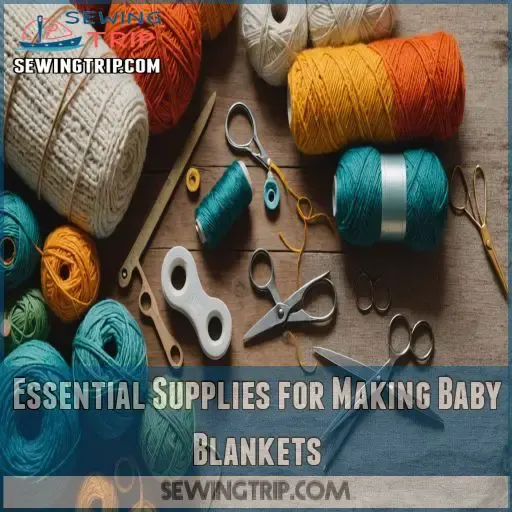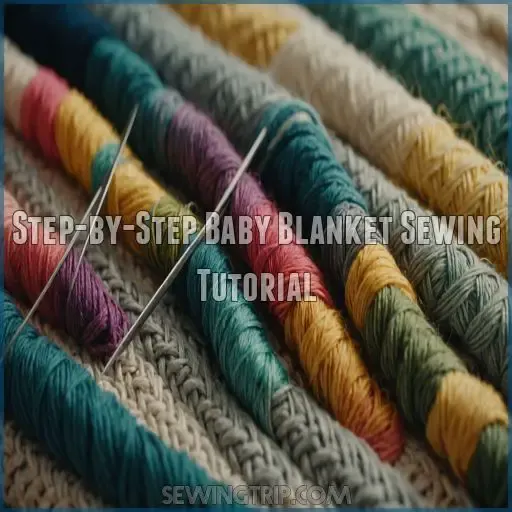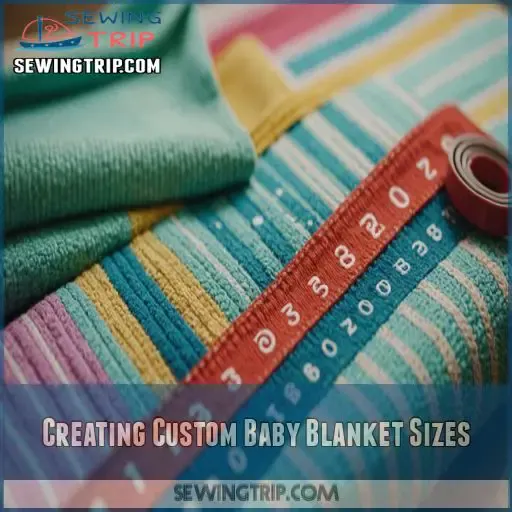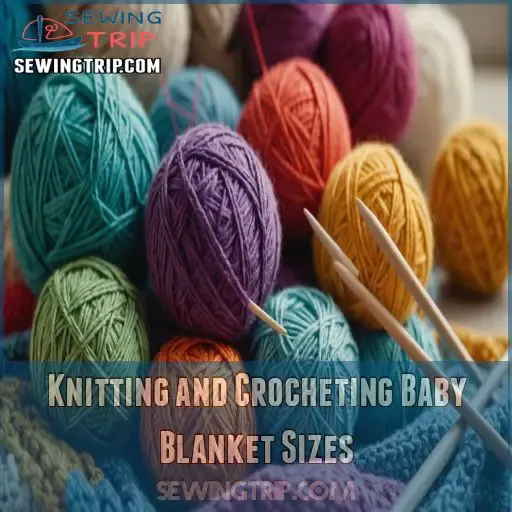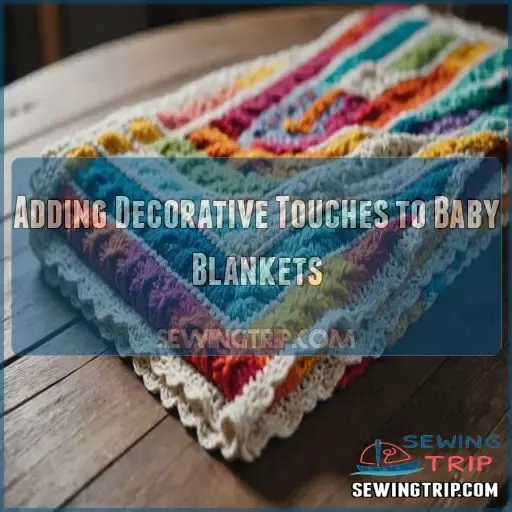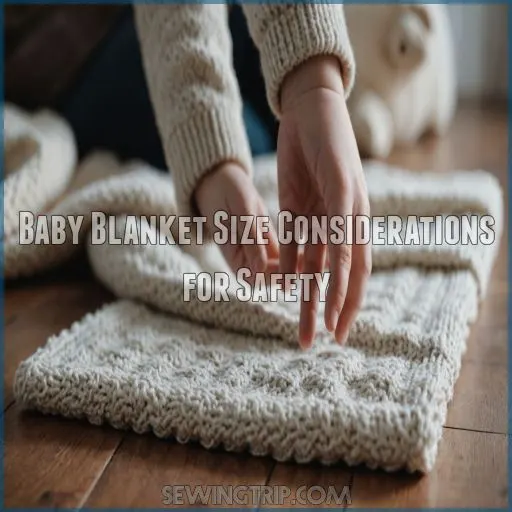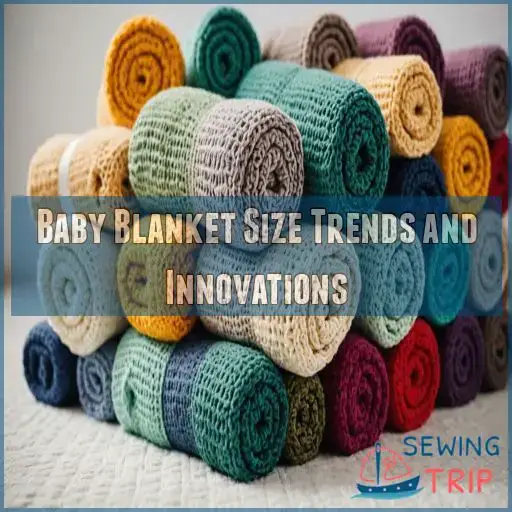This site is supported by our readers. We may earn a commission, at no cost to you, if you purchase through links.
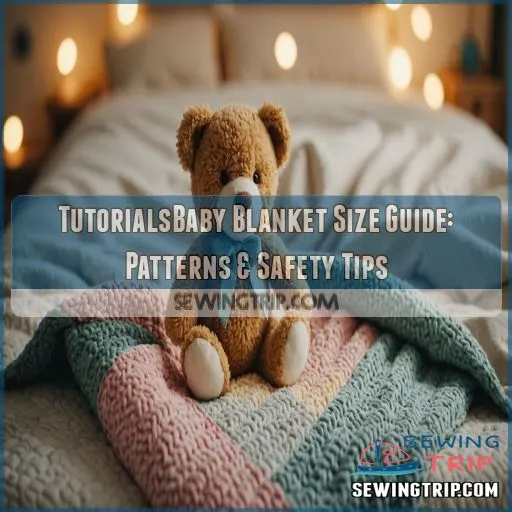 Figuring out baby blanket sizes can feel like threading a needle in the dark, but fear not!
Figuring out baby blanket sizes can feel like threading a needle in the dark, but fear not!
Whether you’re wrapping your little one in a snug receiving blanket or draping a stroller blanket over them, getting the right fit is a piece of cake.
Tutorials on baby blanket sizes often guide you through popular dimensions: think 36" x 36" for a classic security blanket or 45" x 60" for a crib.
Choosing the right size makes sure safety and comfort, like finding that perfect cup of hot cocoa on a chilly day.
Interested in more cozy insights? Keep swaddling on!
Table Of Contents
- Key Takeaways
- Standard Baby Blanket Sizes and Dimensions
- Choosing the Right Fabric for Baby Blankets
- Essential Supplies for Making Baby Blankets
- Step-by-Step Baby Blanket Sewing Tutorial
- Creating Custom Baby Blanket Sizes
- Knitting and Crocheting Baby Blanket Sizes
- Adding Decorative Touches to Baby Blankets
- Baby Blanket Size Considerations for Safety
- Washing and Care Instructions for Baby Blankets
- Baby Blanket Size Trends and Innovations
- Frequently Asked Questions (FAQs)
- Conclusion
Key Takeaways
- Don’t get tangled up in sizes. Baby blankets come in various dimensions, like 36" x 36" for classic security or 45" x 60" for cribs. Picking the right size is as comforting as a warm hug on a cold day.
- Fabrics matter. Cotton flannel is breathable and cozy, while Minky’s velvety softness requires a bit more care like a rag quilt. Choosing fabric that suits your needs is like finding the missing puzzle piece – everything just fits.
- Ready to sew? Gather your superhero tools: a cutting mat, a trusty sewing machine, and colorful threads to match your fabric choices. You’ll be weaving cozy masterpieces in no time – just remember, fabric isn’t coffee, so don’t cut corners.
- Safety first. Avoid blankets large enough to double as a kite. Lightweight, breathable materials keep your baby cozy without the risk, ensuring those sweet dreams aren’t interrupted by big blanket blues.
Standard Baby Blanket Sizes and Dimensions
Whether you’re wrapping a newborn or tucking in a toddler, understanding the different baby blanket sizes helps you be prepared for any cozy moment.
Swaddles and stroller-friendly throws are just two of the many options available.
Let’s explore the variety of options so you can wrap your little one like a burrito—or as close as they’ll let you!
Receiving Blanket Dimensions
The standard receiving blanket measures a cozy 36 by 36 inches, perfect for snuggling newborns. Consider a slightly smaller size for preemies to make sure they fit securely.
Swaddle Blanket Measurements
When searching for the perfect swaddle size, opt for swaddle blanket dimensions around 44" by 44". It’s a snug fit, giving your baby a cozy cocoon!
Crib Blanket Sizes
Crib blankets are cozy companions, typically around 45" by 60". Consider these essentials:
- Choose lightweight materials for safety.
- Opt for breathable fabrics.
- Prioritize machine washable options.
- Explore fun patterns.
Stroller Blanket Specifications
Stroller blankets, like Goldilocks’ porridge, need to be just right—perfect size and weight for weather protection.
Stroller Blanket Specifications
Here’s a quick rundown on stroller blanket specifications:
| Attribute | Measurement | Feature |
|---|---|---|
| Ideal Size | 30" x 40" | Covers snuggly |
| Fabric Weight | Medium | Balance warmth, comfort |
| Attachment Method | Clips | Secures safely |
Choosing the Right Blanket
Make sure the blanket’s the right size and weight to keep your little one cozy and safe without overheating, just like a warming hug on a chilly day!
Security Blanket Dimensions
Security blankets come in handy sizes, usually around 36×36 inches. These cozy companions provide comfort and familiarity for little ones.
Choose soft, breathable fabrics and wash gently to maintain softness.
- Ideal size: 36" x 36"
- Comfort factor: Soft, familiar texture
- Fabric choice: Cotton, flannel, minky
- Washing tips: Gentle cycle, low heat
Choosing the Right Fabric for Baby Blankets
When picking fabric for baby blankets, think soft, snuggly, and easy to wash, so you don’t end up with a grumpy, chilly burrito instead of a happy baby.
From cotton flannel to fleece, each fabric has its perks, just like each guest at a party brings their own charm; remember, the right choice cuddles your little one just like a beloved stuffed animal.
Cotton Flannel Benefits
Cotton flannel’s your go-to for baby blankets—it’s soft, durable, and breathable. Plus, it’s hypoallergenic and easy-care, making sewing tutorials a breeze. Softness with simplicity, who wouldn’t want that?
Minky Fabric Characteristics
As you ponder baby blanket options, consider the velvety softness of Minky fabric. Its durability and warmth make it a cozy choice, though it requires special washing care.
Muslin Material Properties
Muslin’s lightweight, breathable nature makes it a cozy, low-maintenance option for baby blankets. Its soft texture and durability guarantee long-lasting comfort and easy care.
Fleece Fabric Advantages
If you’re looking for fleece fabric, you’re in luck! Enjoy unbeatable softness and warmth. Here’s why this fabric’s a winner:
- Durability
- Machine-washable
- Easy-care
- Cost-effective
Organic Fabric Options
Choosing organic fabric options for a baby blanket feels like wrapping love in a sustainable hug. Look for organic cotton with GOTS certification and eco-friendly dyes.
Essential Supplies for Making Baby Blankets
When you’re making a baby blanket, having the right supplies is like having a superhero tool belt—essential and empowering.
Having the right supplies is key to creating cozy masterpieces.
Fabric-cutting tools, a trusty sewing machine, and colorful threads are all essential for making a baby blanket.
Fabric Cutting Tools
Cutting the fabric precisely is key. Grab a rotary cutter, sharp fabric shears, and a self-healing cutting mat. Measure twice, cut once – safety first when sewing for baby!
Sewing Machine Requirements
Consider a sewing machine that’s user-friendly, with adjustable tension settings and various stitch options.
Utilize the table below to better understand sewing machine requirements.
| Sewing Machine Types | Needle Size | Foot Types | Stitch Options |
|---|---|---|---|
| Basic | 80/12 | Universal Foot | Straight |
| Advanced | 90/14 | Walking Foot | Zigzag |
Working with these elements, you’ll create beautiful baby blankets in no time!
Thread Selection
Thread selection is a balancing act, but fear not! Match thread weight and fiber content to your blanket project for durability.
Color matching is key, like picking a perfect ice cream scoop!
Measuring and Marking Tools
Now that you’ve chosen the perfect thread, grab some reliable measuring and marking tools. Here’s what you’ll need:
- Measuring tapes
- Fabric markers
- Rotary cutters
- Cutting mats
Fabric Pressing Equipment
Grab your trusty iron and ironing board – they’re essential for getting that flannel prepped and pressed to perfection. Try different steam settings to achieve the ideal finish.
Ironing Tools and Techniques
| Iron Types | Pressing Techniques | Steam Options |
|---|---|---|
| Traditional | Smooth Strokes | High |
| Cordless | Gentle Presses | Medium |
| Travel | Vertical Steaming | Low |
| Handheld | Edge Pressing | No Steam |
Step-by-Step Baby Blanket Sewing Tutorial
Ready to make a baby blanket that’s both adorable and practical?
Just grab your fabric, and with a few snips and stitches, you’ll have a cozy masterpiece before you know it!
Prewashing and Preparing Fabric
Imagine fabric like a mischievous elf that loves to shrink! Tame it first. Wash with gentle detergents and embrace ironing techniques. Your blanket’s destined for greatness!
Cutting Fabric to Size
With your fabric prepped, lay it out smoothly. Use cutting tools for precision, ensuring accurate measurements. Sometimes cutting corners works, but not in sewing—measure twice!
Pinning and Sewing Techniques
Now, pin the fabrics together, right sides facing. Sew slowly, keeping the layers smooth and even. Adjust your machine’s tension and stitch length as needed for a professional finish.
Turning and Pressing the Blanket
Smoothly turn your blanket right side out through the gap, like a magician revealing a trick. Press seam allowances flat using medium iron temperature. Master corner techniques carefully.
Topstitching for Durability
Topstitching is your blanket’s secret weapon for durability. Use a durable stitch type and pay attention to stitch spacing. Heavier thread adds strength. Keep your stitching neat!
Creating Custom Baby Blanket Sizes
Creating custom baby blanket sizes lets you design perfectly sized blankets made specifically for your baby’s needs or specific purposes.
Whether you’re making a snug wrap for a tiny newborn or a generous cover for a growing toddler, a little measurement magic and fabric know-how will guide you.
Adjusting Patterns for Larger Blankets
Upsize that pattern with ease – just add a few inches to the dimensions. No need to stress, the extra fabric will make your blanket extra cozy.
Calculating Fabric Requirements
Calculating fabric yardage isn’t rocket science, but it can feel like a puzzle.
Nail down your blanket size and you’ll be golden.
Tips for sewing efficiency:
- Measure twice, cut once.
- Keep those scraps; they add up.
- Balance project cost with quality materials.
Modifying Dimensions for Preemies
Modifying blanket sizes for preemies helps keep them safe and comfortable. Choose lightweight fabric, as they grow fast. Adjust patterns with ease, considering warmth regulation—it’s not rocket science!
Designing Oversized Blankets
Designing an oversized baby blanket? Think creatively! Custom fabric selection opens doors to unique design ideas. Larger pattern adjustments make sure a perfect finish. Consider blanket weight for cozy cuddles!
Adapting Sizes for Different Uses
Customize blanket sizes to suit your needs – from cozy toddler throws to compact travel blankets. Get creative and craft the perfect fit for every occasion!
- Toddler Blanket Sizes: Opt for 36" x 48" for ample coverage and easy maneuverability.
- Preemie Blanket Needs: Downsize to 30" x 30" for a snug, secure fit.
- Travel Blanket Dimensions: 40" x 50" strikes the right balance of warmth and portability.
Knitting and Crocheting Baby Blanket Sizes
When you’re knitting or crocheting baby blankets, you’ll want to pick soft yarn that’s gentle on baby’s skin and easy to care for.
Understanding gauge and tension will help make sure your blanket doesn’t end up looking like a quirky abstract art piece, unless that’s the look you’re going for!
Yarn Selection for Baby Blankets
Let’s talk yarn selection! Pick soft fibers like cotton or bamboo for baby blankets. They’re durable and offer color choices galore. Also, check care instructions for hassle-free washing.
Gauge and Tension Considerations
After picking your yarn, gauge and tension become your new best friends. Watch these factors like a hawk:
- Yarn weight affects project size.
- Needle size influences stitch size.
- Fabric stretch determines fit.
Standard Knitted Blanket Dimensions
When knitting baby blankets, aim for standard sizes like 36×36 inches. Gauge and needle size impact the final dimensions, so swatch first to get the perfect fit.
Crochet Stitch Patterns and Sizes
Explore crochet stitch variations and sizes!
- Consider the stitch gauge impact.
- Choose blanket edge styles wisely.
- Pay attention to yarn weight effect.
- Assess pattern complexity carefully.
Adjusting Patterns for Custom Sizes
Customizing patterns can feel like figuring out a maze, but you’ll master it!
Here’s a quick guide for blanket size and fabric yardage:
| Blanket Size | Yarn Required | Note |
|---|---|---|
| Preemie | 300 yards | Snuggly fit! |
| Baby | 500 yards |
Standard size.
Cozy coverage.
Adding Decorative Touches to Baby Blankets
Adding decorative touches to baby blankets can transform an ordinary cover into a cozy masterpiece.
Whether you’ve got an embroidery needle or a knack for appliqué, your creative flair adds love and personality—and maybe a dash of pizzazz to keep your baby cooing with delight.
Embroidery Techniques for Personalization
Personalize your baby’s blanket with embroidery!
From sweet monograms to playful designs, the possibilities are endless.
Get creative with thread colors and stitch types for a truly unique touch.
Embroider a favorite animal or nursery theme.
Experiment with different font styles and placement.
- Monogram baby’s initials for a classic look
- Embroider a favorite animal or nursery theme
- Experiment with different font styles and placement
Appliqué Design Ideas
Adding appliqué to baby blankets lets you express creativity. Try animal motifs, floral patterns, or geometric shapes. Mix monogram designs and playful lettering styles for a unique touch.
Decorative Edging Options
Appliqué designs give character, but let’s edge things up with options like:
- Crochet borders for texture.
- Scalloped edges add whimsy.
- Fabric bindings for definition.
- Simple hems.
Incorporating Ribbons and Trim
Aside from adding charm, ribbons and trim can transform your baby blanket.
Play with ribbon placement and trim styles, but remember safety concerns.
Consider sewing techniques:
| Color Idea | Trim Style |
|---|---|
| Pastel Palette | Lace Edging |
| Primary Colors | Satin Ribbon |
| Monochrome | Bias Binding |
Quilting Patterns for Baby Blankets
Quilting patterns for baby blankets add a touch of elegance and personalization. Try modern designs, traditional motifs, or mix fabrics for a one-of-a-kind creation.
- Explore simple geometric quilting patterns for a clean, minimalist look.
- Incorporate appliqué shapes like stars, hearts, or animals for a whimsical feel.
- Experiment with patchwork or strip quilting techniques for a cozy, homespun aesthetic.
- Choose coordinating fabrics that complement your nursery’s color scheme or theme.
Baby Blanket Size Considerations for Safety
Choosing the right baby blanket size isn’t just about aesthetics; it’s a matter of safety.
You don’t want a blanket large enough to swallow your little one or heavy enough to rival a sumo suit!
SIDS Prevention Guidelines
To make sure safe sleep and prevent suffocation risks, prioritize blanket weight and sleep environment. Stay alert with these guidelines:
| Factor | Recommendation |
|---|---|
| Blanket Weight | Lightweight |
| Sleep Position | Back is best |
| Sleep Surface | Firm mattress |
| Temperature | Room-temperature |
Safe sleep is critical for infants.
Prioritize blanket weight and sleep environment to reduce suffocation risks.
Age-Appropriate Blanket Sizes
When choosing a toddler blanket size, balance cozy and safe. For car seats and strollers, opt for smaller sizes while keeping newborn blanket weight light and breathable.
Avoiding Suffocation Hazards
Steer clear of bulky blankets that could smother your little one. Opt for lightweight, breathable fabrics that won’t pose a suffocation hazard in the crib or during co-sleeping.
Temperature Regulation and Blanket Weight
Blanket weight matters. Match the baby blanket’s TOG rating to the room temperature for sleep safety. Cotton? Fleece? Choose wisely—warm but not too toasty.
Blanket Sizes for Different Sleep Environments
As you make sure baby’s comfort, consider sleep environments: cribs, bassinets, or playpens. Baby blanket sizes vary, so choose wisely! Make sure snug fits—like Goldilocks, not too big!
Washing and Care Instructions for Baby Blankets
Keeping your baby’s blanket clean and cozy is easier than you think—no magic wand required.
We’ll guide you through washing and drying tips, so your little one’s favorite blankie stays soft, fresh, and ready for snuggles.
Recommended Washing Temperatures
Wash baby blankets in warm or cool water to preserve softness and colors. Avoid hot water, which can damage delicate fabrics. Check care labels for specific instructions.
Drying Methods for Different Fabrics
After choosing the perfect washing temperature, you’ll want to dry your baby blanket carefully. Here’s a quick guide:
- Air drying: Preserve softness, reduces shrinking.
- Tumble drying: Low heat, constant fluff.
- Line drying: Sunshine’s natural magic.
Drying time: Depends on blanket thickness.
Fabric softener: Skip it, causes build-up.
Stain Removal Techniques
| Stain Type | Natural Remover | Safe Product |
|---|---|---|
| Milk | Club Soda | Baby-friendly Detergent |
| Fruits | Lemon Juice | Enzyme Cleaner |
| Dirt/Mud | White Vinegar | Oxi-based Cleaner |
Storing Baby Blankets Properly
Got those stains out? Great! For blanket storage tips, use breathable bags. Slide them under beds or in closets. Keep moths away with lavender sachets. Your space-saving hero!
Maintaining Softness and Durability
Keeping your baby blanket soft and durable is no rocket science, especially when you know how to choose the right fabric! Here’s the scoop:
- Choose suitable fabrics.
- Wash gently.
- Use low heat.
- Store carefully.
Baby Blanket Size Trends and Innovations
You’re about to discover the latest trends in baby blanket sizes that can adapt like a superpower to meet modern needs.
From snuggly convertible designs to eco-friendly options, these innovations will make you ponder if they’re crafted by baby blanket wizards!
Convertible Blanket Designs
While you’ve mastered washing baby blankets, now let’s chat about convertible designs. These versatile wonders can grow with your child, offering flexibility and safety. Perfect for adventures!
Multi-functional Blanket Sizes
Nowadays, multi-purpose blankets offer endless versatility – from cozy car rides to comfy pet naps. Discover the perfect sizes for your family’s needs and lifestyle.
- Convertible travel blankets
- Oversized toddler-friendly throws
- Compact lap blankets for wheelchairs
- Generously-sized pet blankets
- Lightweight yet warm outdoor throws
Eco-friendly Size Considerations
Why not make your blanket eco-friendly too? Opt for sustainable materials and ethical production. This helps minimize waste and extends your blanket’s lifespan. Simple changes, big impact!
Cultural Variations in Blanket Sizes
Throughout history, blanket traditions have woven their way into cultural preferences. Size symbolism reflects regional variations and historical influences, creating rich diversity in beloved baby blanket styles.
Technology-integrated Baby Blankets
Imagine a baby blanket with smart-blanket features—sensor technology and app integration ensuring temperature control and safety features. It’s like having a tech-savvy nanny in your nursery!
Frequently Asked Questions (FAQs)
What is a good size for a homemade baby blanket?
A good homemade baby blanket measures around 36" by 36"—just the right size to swaddle your little one like a cozy burrito, ensuring comfort and warmth.
It’s simple to make and perfect for a thoughtful gift.
What is the standard baby blanket size in knitting?
Knitting a baby blanket is like weaving a tale of comfort.
A standard size is 36 by 36 inches.
It makes sure the little one is wrapped in warmth, like a cozy hug from grandma on a chilly day.
How do I choose the right yarn weight for a baby blanket?
Pick yarn weight by considering the blanket’s purpose and season. Fingering yarn works for lightweight, summer blankets, while bulky yarn suits warm, cozy winter blankets.
Make sure it’s soft and machine-washable—parents will thank you!
Keep the baby cozy!
What are some beginner-friendly crochet stitches for baby blankets?
For beginner baby blankets, you can’t go wrong with classic stitches like single crochet, half double crochet, or the easy-peasy granny square.
They’re super cozy and you’ll have that blanket done in no time!
How can I crochet a baby blanket quickly?
Want to whip up a baby blanket faster than you can say "cozy cuddles"?
Use super bulky yarn and a big hook for speed.
Try the simple granny square stitch—it’s easy, quick, and looks fantastic.
Happy crocheting!
What are the different types of baby blanket sizes?
You’ve got various baby blanket sizes, each serving a unique purpose: standard baby blanket (36” x 36”), crib blanket (45” x 60”), swaddle (44” x 44” or 40” square), receiving (36” x 36”), and stroller (30” x 40”).
How do I calculate the number of stitches to cast on for a baby blanket?
Calculate stitches for a baby blanket by checking your yarn label for gauge.
Multiply the blanket width by stitches per inch.
Adjust for design elements like borders or patterns.
It’s like baking—follow the recipe but customize to taste!
Conclusion
Mastering baby blanket sizes is like finding the perfect cozy spot on a chilly day – with the right tutorials, you’ll be swaddling your little one in comfort and style in no time.
From classic security blankets to versatile stroller sizes, our detailed guide covers all the baby blanket size essentials to ensure your little one stays safe, snug, and oh-so-adorable.
So grab your needles, thread, and a mug of hot cocoa – it’s time to get crafty!

